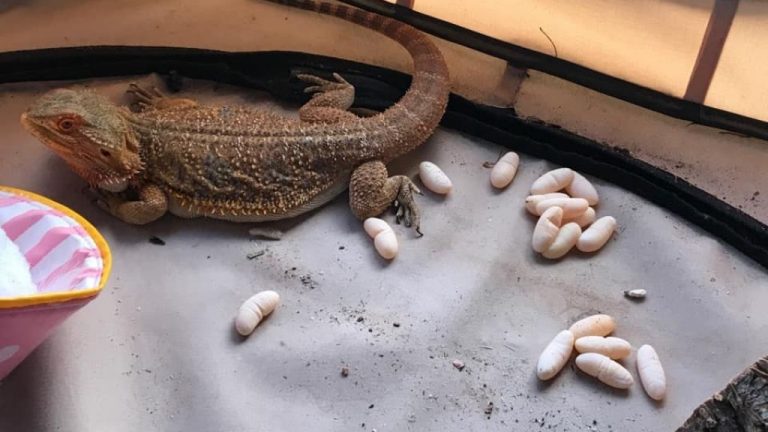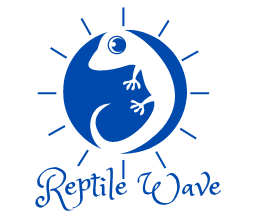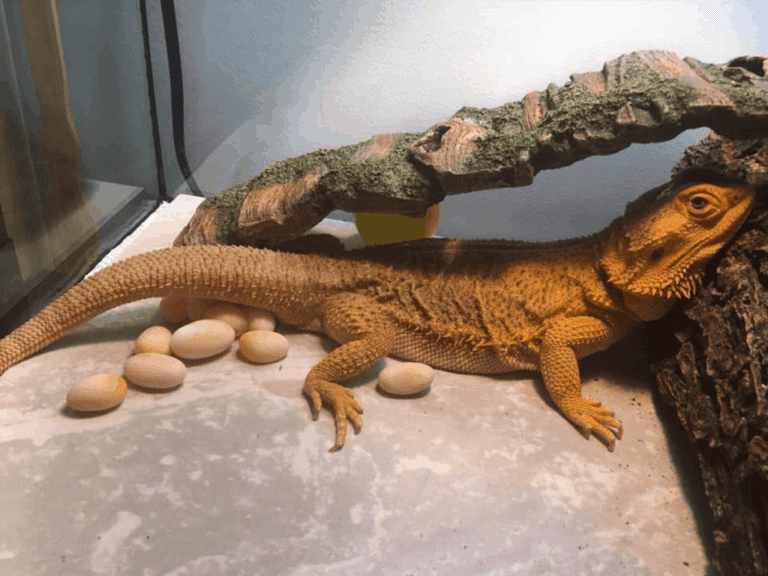Bearded dragon eggs are usually white or a bit off-white when they’re laid. But if they turn yellow, that could mean there’s a problem like the eggs not being able to grow into baby dragons, or there might be germs or mold. Eggs that are growing well should stay the same color all the way until they hatch.
However, if you see yellow in the eggs, it’s really important to watch out for issues. Take out any eggs that won’t become baby dragons so they don’t cause problems for the healthy ones. Making sure the eggs are kept in the right conditions, like the right temperature and humidity, is super important.
How Does Egg Color Reflect Bearded Dragon Health?

These nuances in egg coloration provide caregivers with valuable insights into the reproductive health of bearded dragons.
Normal Egg Color (White or Off-White)
Bearded dragon eggs are generally laid with a coloration that is either white or slightly off-white. The natural color can be influenced by factors such as the age of the eggs and the substrate on which they are laid.
It’s important to establish a baseline understanding of the normal color to identify any abnormal changes during the incubation period.
Yellow Hue as a Sign of Potential Problems
Infertility
Infertile eggs may develop a yellow tint as they undergo breakdown processes. The presence of a yellow color is a visible indicator that the egg did not undergo successful fertilization. Moreover, regular monitoring is essential to identify and remove infertile eggs, preventing potential issues.
Bacterial or Fungal Infections
Yellowing of bearded dragon eggs can result from bacterial or fungal infections. Infections may compromise egg health, leading to discoloration and potential harm to viable ones.
Maintaining a clean and hygienic incubation environment is crucial to minimize the risk of infections.
Mold Growth
Mold growth on the eggs can contribute to a yellow hue. Mold is harmful to both developing embryos and the structural integrity of the eggs. Timely identification and removal of eggs affected by mold are vital to safeguard the health of the entire clutch.
Furthermore, grasping these nuances in egg coloration provides caregivers with valuable insights into the reproductive health of bearded dragons.
How Can Monitoring Ensure Proactive Action in Bearded Dragon Care?
The significance of close monitoring and taking proactive measures, such as removing problematic eggs, is pivotal in ensuring a successful hatching process.
Importance of Closely Monitoring Eggs
Regular monitoring of bearded dragon eggs during the incubation period is crucial for ensuring the health and development of the embryos. Visual inspections should be conducted to detect any changes in color, texture, or condition of the eggs.
Monitoring allows caregivers to identify potential issues early, enabling timely intervention and prevention of complications.
Removing Infertile or Unhealthy Eggs
Infertile eggs or those showing signs of poor health should be promptly identified and removed from the clutch. In addition, infertile eggs can become a breeding ground for bacteria or fungi, potentially affecting the entire clutch.
Removal minimizes the risk of contamination and allows for focused care on viable eggs, optimizing the chances of successful hatching.
Preventing Potential Harm to Viable Eggs
Creating a controlled and clean incubation environment is essential for preventing harm to viable eggs. Infertile or unhealthy eggs left within the clutch can pose a threat to the well-being of healthy, developing embryos. Mold or bacterial growth on neglected eggs may spread, affecting neighboring eggs and jeopardizing the overall health of the clutch.
In addition, maintaining proper humidity levels, temperature, and cleanliness in the incubation setup contributes to a conducive environment for the healthy development of viable eggs.
What Are Essential Incubation Conditions?
Proper incubation conditions are crucial for the successful development of bearded dragon eggs.
The Role of Temperature and Humidity
Temperature Considerations
| Temperature Considerations | Description |
| Development Influence | Bearded dragon eggs are ectothermic, meaning their development is strongly influenced by external temperatures. |
| Optimal Temperature Range | The recommended temperature for incubating bearded dragon eggs is generally between 80 to 85 degrees Fahrenheit (27 to 29 degrees Celsius). |
| Impact of Deviations | Deviations from this optimal temperature range can have significant consequences, including issues like developmental abnormalities or delayed hatching. |
Humidity Importance
Proper humidity is crucial when hatching eggs. Aim for a humidity level between 70% and 80%. This helps prevent the eggs from drying out, making sure the baby animals inside stay hydrated as they grow.
If the humidity is too low, the babies might not grow well, have trouble hatching, or even not make it. So, make sure there’s enough moisture during this process.
Thermoregulation and Embryo Development
The heat decides if bearded dragon babies will be boys or girls. It’s called temperature-dependent sex determination (TSD). The warmth during certain parts of egg hatching can make the eggs turn into either boys or girls.
In addition, knowing how temperature, TSD, and baby dragon growth connect is really important for breeders who want a certain number of boy or girl hatchlings.
Appropriate Incubation Conditions for Healthy Development
Monitoring Equipment
Reliable incubators equipped with accurate temperature and humidity controls are essential. Regularly calibrating and checking the accuracy of these instruments is crucial to ensure a stable environment.
Egg Positioning
Properly positioning the eggs during incubation is vital. Avoiding direct contact with the heating element prevents uneven temperature distribution.
Turning the eggs regularly helps prevent the embryos from sticking to the membrane, promoting proper development.
Substrate and Nesting Material
The choice of substrate in the incubation container is important. Vermiculite or perlite mixed with water is a common and effective choice.
Furthermore, the substrate should be damp but not overly wet, striking a balance to maintain the necessary humidity without causing problems like mold growth.
Ventilation
Adequate ventilation is necessary to prevent the buildup of carbon dioxide within the incubator.
However, excessive airflow may lead to rapid moisture loss, affecting humidity levels. Striking the right balance is key.
Regular Monitoring and Adjustments
Consistent monitoring of temperature and humidity is necessary throughout the entire incubation period.
Making adjustments as needed based on environmental conditions and the developmental stage of the eggs ensures a stable and optimal environment for healthy embryo development.
Documentation and Record-Keeping
Keeping detailed records of incubation conditions, including temperature, humidity levels, and any adjustments made, helps identify patterns and facilitates better future incubation practices.
Documentation is particularly important for breeders aiming to refine their breeding techniques or troubleshoot potential issues in the incubation process.
FAQ’s
Yes, it’s important to remove unhealthy or yellow-tinted eggs promptly to avoid potential issues.
There is no specific “yellow disease.” Yellowing in bearded dragon eggs may indicate problems like infertility, infections, or mold.
No, it’s best to avoid touching bearded dragon eggs as the oil on human skin can be harmful. Use caution and handle them only when necessary.
While they can eat eggs occasionally, a diet mainly consisting of insects and vegetables is healthier for bearded dragons.
Yes, some lizard species, including bearded dragons, can lay eggs without mating. These eggs will be infertile.
Yes, maintaining the proper temperature, generally between 80 to 85 degrees Fahrenheit, is crucial for the healthy development of bearded dragon eggs.
Final Words
In summary, the color of bearded dragon eggs tells us a lot about their health. Normally, they are white or a little off-white. But if they turn yellow, there might be problems like the eggs not growing into baby dragons, or having germs or mold. It’s super important to keep a close eye on them during the incubation time so that caregivers can quickly remove any unhealthy eggs.
In addition, making sure the eggs are in the right conditions, like the right temperature and humidity, is really important for a successful hatching. Taking good notes and keeping records helps breeders improve their methods and take care of the eggs better.

